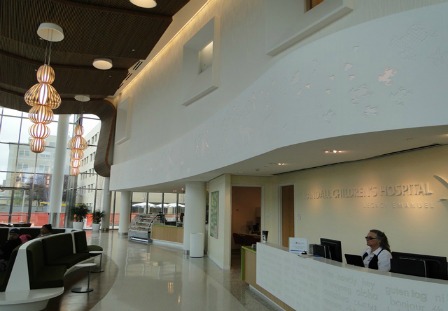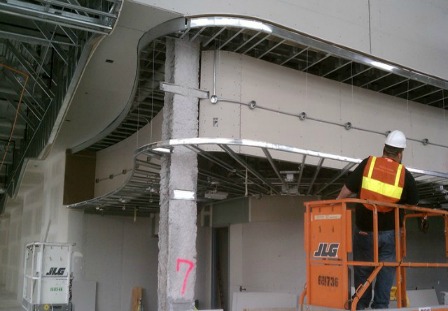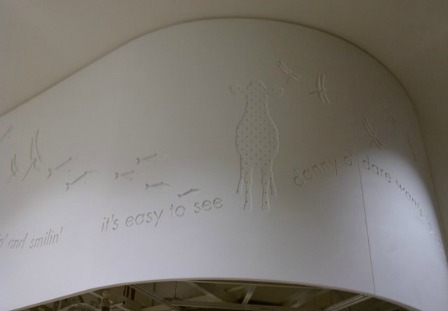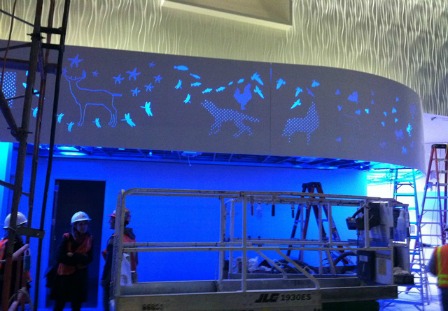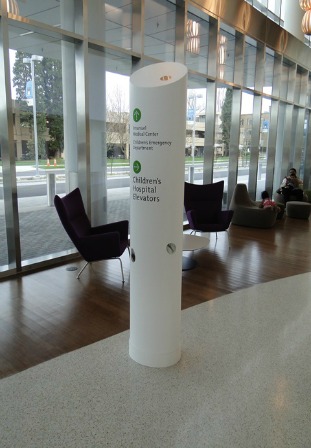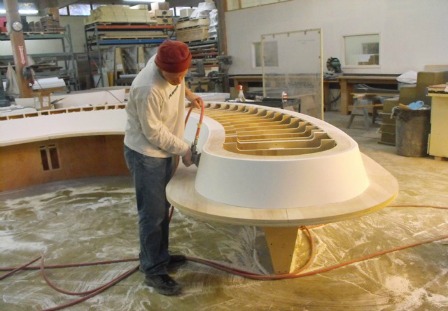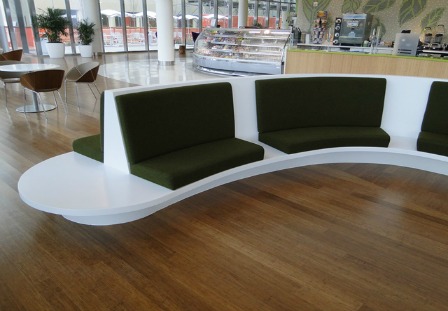Countertops Magazine Archive
Job Jacket: Children’s Hospital at Legacy Emanuel
Randall Children’s Hospital at Legacy Emanuel:
Multiple complex solid surface projects encompassed in this commercial job
R.D. Wing Co., Inc., a premier solid surface fabricator in Kirkland, Wash., was contacted by Zimmer Gunsul Frasca (ZGF) Architects LLP in Portland, Ore., to create some complex Corian submittal samples for an upcoming expansion to the Randall Children’s Hospital at Legacy Emanuel. The design ZGF had come up with would utilize Corian in some of the most unique ways possible. They wanted to create an environment for children that eliminated the sterile confines of a traditional hospital by eliminating any straight walls, ceiling and sterile surfaces. Their ambitious plan was to maximize the solid surface within the hospital for all its healthcare benefits, while creating warm inviting surfaces with artwork, colors, textures and depth. Most of the hospital transaction surfaces were to be Corian, but they also wanted thermoformed vertical nurse’s stations panels, cylindrical way-finding pillars, a large thermoformed lobby bench, glass fronted solid surface shadow boxes, and the main lobby feature of a 240-ft.- long thermoformed art frieze ribbon suspended 14 ft. in the air with illuminated animals and text etched into the surface.
-
Figure 1 – One aspect of this massive project was to create a focal point of the hospital lobby in the form of a 240-ft.-long by 5-ft.-tall Art Frieze Ribbon suspended 14 ft. in the air.
ZGF had reached out to a few companies in the Portland area, but the samples produced did not capture their intent nor did they feel that on a grand scale they would receive the desired products. After speaking with Willis Supply, the local DuPont distributor, ZGF was connected with R.D. Wing Co. Inc. who had the skills and ability to fabricate what ZGF had designed. R.D. Wing provided submittal samples and gave expert advice on the best ways to fabricate and install the desired products.
-
Figure 2 – Artek, an architectural millwork company, partnered with R.D. Wing Co. to design the Art Frieze Ribbon and fabricated the steel support structure to hold it in place.
The majority of the highly visible and complex solid surface projects were fabricated by R.D. Wing Co. within the Randall Children’s Hospital at Legacy Emanuel. This highly complex project included an led-lit ribbon panel, nurses’ stations, cylindrical way-finding pillars, a formed bench for the main lobby and glass-fronted shadow boxes.
Art Frieze Ribbon
The main feature of the hospital is an expansive two story lobby. Within the lobby, the focal point is a 240-ft.-long by 5-ft.-tall Art Frieze Ribbon suspended 14 ft. in the air (see Figure 1). Artek, an architectural millwork company based in Portland, Ore., partnered with R.D. Wing Co. to design the Art Frieze Ribbon and a steel support structure. Artek fabricated the steel structure and installed it on site (see Figure 2).
-
Figure 3 – The ribbon was etched with animals and text that, when backlit, would allow more light to shine through.
Once the metal structure was complete, R.D. Wing Co. used a laser locating system to map the on-site geometry of the structure. From that, the correct radii were determined for mold productions. The first step in the fabrication process was to create blanks that were 5- by 5-ft. at ½-in.-thick in Glacier White Corian. The blanks were etched with animals and text on the front (see Figure 3).
-
Figure 4 – The ribbon was lit with hidden LED lighting, which changed colors, creating a rainbow effect.
The design of the ribbon took it throughout the lobby, around some corners and into the eating area. Of the 240-ft. length, only five blanks were flat. The rest had to be thermoformed to their specific radii. On the back of the completed panels a French cleat was formed and attached that corresponded to hangers on the metal structure. R.D. Wing Co. installed the panels on-site, field seaming them into 20-ft.-long lengths. Every 20 ft. a silicone expansion joint was included to allow for movement within the completed ribbon. Within the hollow metal structure, large LED light arrays were installed that changed colors, giving the illuminated ribbon a rainbow effect (see Figure 4). The areas that were etched with animals or text allowed more light to travel through the solid surface, making them even more bright and illuminated than the surrounding full thickness areas. The result is a stunning monolithic appearing ribbon that undulates in and out of the main lobby with lights, colors and shapes.
Nurses’ Stations
R.D. Wing Co. partnered with Morales Vanblokland Inc. (a fabricator in Bend, Ore.) to fabricate the thermoformed Nurse’s Station corner rounds. The Corian corner rounds averaged 30 in. tall by 60 in. long and were ½-in. thick in the color Glacier White. The surface was relieved with text and animal shapes. The backside was masked and painted with an auto-grade paint everywhere except for where the animal shapes were etched. The panels were then heated and formed to the correct radii. The final step was to trim the panels to size and finish sand the surfaces. The panels were installed by Morales Vanblokland Inc. into the corners of each of the nurse’s stations. At night the panels are illuminated allowing light to only come through the etched shapes.
-
Figure 5 – Numerous 8-ft-high hourglass shaped cylindrical way-finding pillars were created from solid surface for the project. They were thermoformed in two pieces and then joined on site.
Cylindrical Way-finding Pillars
An artistic design/build company, Pathway Design of Portland, Ore., worked in tandem with ZGF Architects to create three 8-ft-high hourglass shaped cylindrical way-finding pillars (see Figure 5). R.D. Wing Co., Inc. was contacted to fabricate the solid surface pillars. First, clamshell thermoforming molds were made for each half of the pillars. The ½-in.-thick Glacier White Corian was heated and pressed into the two-part clamshell molds. Once cured, the solid surface was trimmed to size and holes drilled in their proper locations. Solid acrylic rods, 4 in. in diameter, were glued into the holes at odd angles. In the center of the acrylic rods, colored velum was attached. As kids look into the acrylic rods, the velum creates a kaleidoscope effect. The two halves of each pillar were glued together locking in the rods. The tops were glued into position and all the units were finish sanded.
R.D. Wing Co. designed, built and installed the invisible hardware mounting bracket that was used onsite. Additional vinyl graphics were added to the outside of the pillars for way-finding.
-
Figure 6 – Creating a set of thermoformed solid surface benches was another aspect to the project. The wooden support structure was used to mold the material.
Main Lobby Formed Bench
Another part of Artek’s scope of work was to create a snaking bench made from Glacier White Corian. Artek fabricated the wood substructure of the bench. It was divided into 4 sections for transportation and installation. R.D. Wing Co., Inc. was contracted with fabricating the Corian skin surrounding the substructure. Using the bench itself as the mold, the solid surface was heated to forming temperature and laid against the substructure for curing. Once cured, the formed panels were placed next to each other and scribed to a perfect fit. The Corian was permanently adhered to the substructure sections and pre-fit for installation (see Figure 6). R.D. Wing Co., Inc. delivered the bench on-site, field seamed the sections, mounted the full unit to the floor and sanded the entire surface to the desired finish. The final step was to install the custom made green seat cushions onto the bench (see Figure 7).
-
Figure 7 – These unique solid surface benches were created to adorn the lobby to the hospital.
Glass-fronted Shadow Boxes
Soelzer Contracting, Inc., based in Portland, Ore., working with designers at ZGF Architects, came up with a plan to incorporate solid surface shadowboxes down the main corridor leading off the entrance lobby. Each shadowbox was filled with an alphabet letter and corresponding items that started with that letter. R.D. Wing Co., Inc. was asked to fabricate the ½-in.-thick Glacier White Corian shadow boxes.
To construct the pentagon shaped shadow boxes, five individual panels were cut to size. The inside was machined down to 3/8-in. thick leaving a lip on the outside of each. A small window was machined in the center of the top two panels which was then filled with a corresponding piece of clear acrylic. These acted as skylights to illuminate the contents of the shadow boxes. An angle was cut onto two sides of each panel to allow the five panels to fit together properly. Using a glue fixture, the panels were located corrected and glued together. All the surfaces were sanded to a matte finish. A piece of glass was silicone inside the remaining solid surface lip and a laser cut piece of wood paneling was placed behind the glass. Soelzer Contracting added the contents behind the wood paneling and installed the boxes onto the wall throughout the main corridor.
According to Willis Supply, the Randall Children’s Hospital at Legacy Emanuel is the largest installation of DuPont Corian in the state of Oregon to date.
For more information, contact: R.D. Wing Co., Inc., 11809 NE 116th St., Kirkland, WA 98034, (877) 988-8400
Zimmer Gunsul Frasca (ZGF) Architects LLP, 1223 SW Washington St., Suite 200, Portland, OR 97205, (503) 224-3860
Artek, 9790 SW Sunshine Ct., Beaverton, OR 97005, (503) 641-6877
Morales Vanblokland Inc., 20732 High Desert Ct., Bend, OR 97701, (541) 389-4280
Pathway Design, Landon Marsh, 8890 SW Laurel Leaf Ter., Portland, OR 97225, (503) 740-2456
Soelzer Contracting, Inc., 933 S.E. River Forest Ct., Portland, OR 97267, (503) 659-5718
|

